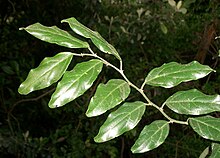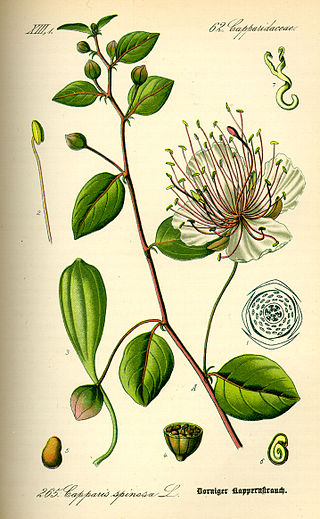
Capparis spinosa, the caper bush, also called Flinders rose, is a perennial plant that bears rounded, fleshy leaves and large white to pinkish-white flowers.
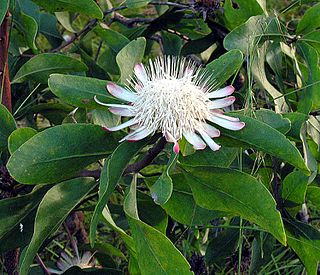
Protea gaguedi is a species of tree which belongs to the genus Protea.

Protea welwitschii is a species of shrub or small tree which belongs to the genus Protea, and which occurs in bushveld and different types of grassland.

Senecio barbertonicus, the Barberton groundsel or succulent bush senecio, is an evergreen succulent shrub of the family Asteraceae and genus Senecio, native to Southern Africa, named after one of its native localities Barberton and is now also being cultivated elsewhere for its drought resistance, clusters of sweetly scented, golden-yellow, tufted flower heads in winter and attractiveness to butterflies, the painted lady butterfly in particular.

Capparis is a genus of flowering plants in the family Capparaceae. It includes 142 species of shrubs or lianas which are collectively known as caper shrubs or caperbushes. Capparis species occur over a wide range of habitat in the subtropical and tropical regions of Africa, Eurasia, Australasia, and the Pacific.
Triclisia macrophylla is a species of plant in the family Menispermaceae. It is a climbing shrub producing stems 10 - 20 meters long. It is found in Cameroon, Equatorial Guinea, and Sierra Leone. Its natural habitats are subtropical or tropical moist lowland forest and subtropical or tropical moist montane forest. It is threatened by habitat loss.

Solenangis is a genus of flowering plants from the orchid family, Orchidaceae. It is native to sub-Saharan Africa.

Sevenia boisduvali, the Boisduval's tree nymph, is a butterfly in the family Nymphalidae. There are four subspecies; all native to Africa.

Capparis tomentosa, the woolly caper bush or African caper, is a plant in the family Capparaceae and is native to Africa.
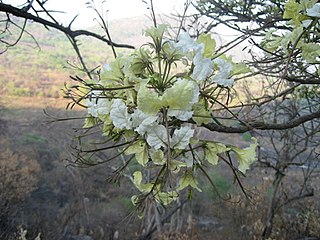
Crateva kirkii, commonly known as the three-finger bush, is a small deciduous tree belonging to the Capparaceae or caper family. It ranges through eastern and southern Africa, including Kenya, Tanzania, Democratic Republic of the Congo, Malawi, Mozambique, Zambia, Zimbabwe, Eswatini, and KwaZulu-Natal province of South Africa.

Erianthemum dregei is a species of parasitic plant in the family Loranthaceae, and is commonly known as the hairy mistletoe or wood flower.
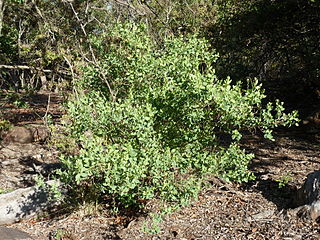
Clutia pulchella, the lightning bush, is a southern African dioecious shrub of the family Peraceae. It occurs at middle altitudes in Namibia, Mozambique, Zimbabwe, Eswatini, Botswana, Lesotho and South Africa.

Maerua angolensis is a 10m tall, occasionally deciduous tree of the Capparaceae or caper family, often growing on termitaria and in thickets fringing seasonal watercourses, up to 1800m. Though never common, it is widespread in tropical Africa and arid regions, being absent from high-rainfall regions.

Boscia foetida, commonly known as the stink shepherd's tree and the smelly shepherd's bush, is an evergreen shrub or tree that is native to the warmer and drier parts southern Africa. It is found in semi-desert and arid bushveld, and in the west it occurs commonly in areas which are otherwise sparsely wooded. It is known for the particularly unpleasant smell of its flowers which appear during early spring, to which its specific name foetida alludes. Its freshly cut wood likewise has an unpleasant smell, and has traditional medicinal and magical uses, for instance as a protection against lightning. In central Botswana the village of Mopipi is named after this species.
Barleria elegans is a species of plant in the family Acanthaceae. It is a spiny perennial herb or subshrub native to Angola and Namibia, and to Mozambique, Zimbabwe, Eswatini, and the Northern Provinces and KwaZulu-Natal in South Africa.
Vachellia kirkii, formerly classified as Acacia kirkii, is a tree species native to tropical Africa, but now attributed to the genus Vachellia, It is commonly known as the flood plain acacia.

Mundulea sericea, the cork bush, is an attractive shrub or small tree which is found in relatively open woodlands of Africa and South Asia. It is the only member of the genus with a range extending beyond Madagascar, and it resembles some African shrubs in the related genus Tephrosia.
Nymphaea petersiana is a species of the genus Nymphaea native to the region spanning from Tanzania to South Africa.




